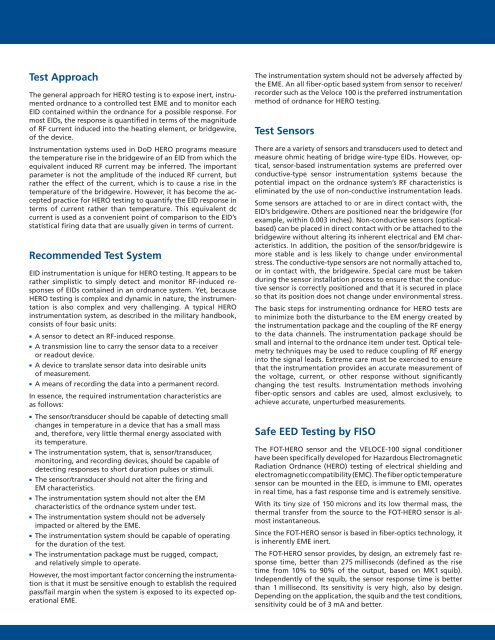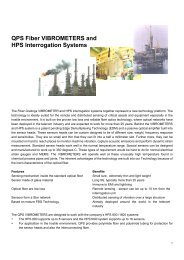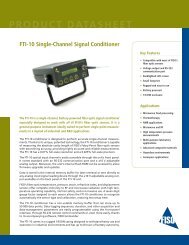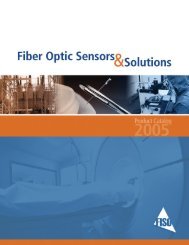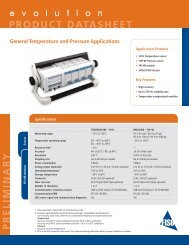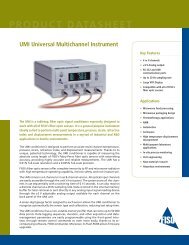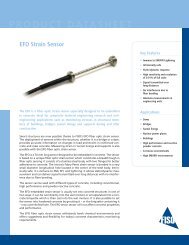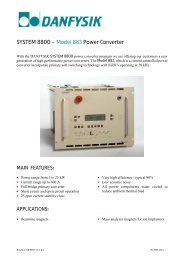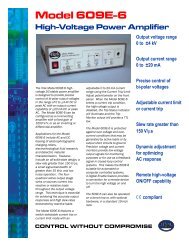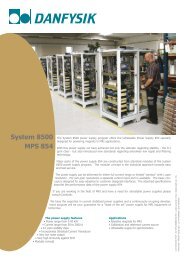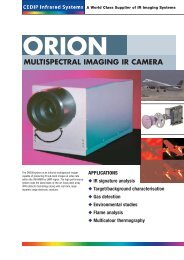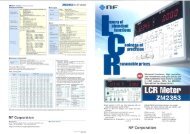Download application note - FISO Technologies, Inc.
Download application note - FISO Technologies, Inc.
Download application note - FISO Technologies, Inc.
Create successful ePaper yourself
Turn your PDF publications into a flip-book with our unique Google optimized e-Paper software.
Test Approach<br />
The general approach for HERO testing is to expose inert, instrumented<br />
ordnance to a controlled test EME and to monitor each<br />
EID contained within the ordnance for a possible response. For<br />
most EIDs, the response is quantified in terms of the magnitude<br />
of RF current induced into the heating element, or bridgewire,<br />
of the device.<br />
Instrumentation systems used in DoD HERO programs measure<br />
the temperature rise in the bridgewire of an EID from which the<br />
equivalent induced RF current may be inferred. The important<br />
parameter is not the amplitude of the induced RF current, but<br />
rather the effect of the current, which is to cause a rise in the<br />
temperature of the bridgewire. However, it has become the accepted<br />
practice for HERO testing to quantify the EID response in<br />
terms of current rather than temperature. This equivalent dc<br />
current is used as a convenient point of comparison to the EID’s<br />
statistical firing data that are usually given in terms of current.<br />
Recommended Test System<br />
EID instrumentation is unique for HERO testing. It appears to be<br />
rather simplistic to simply detect and monitor RF-induced responses<br />
of EIDs contained in an ordnance system. Yet, because<br />
HERO testing is complex and dynamic in nature, the instrumentation<br />
is also complex and very challenging. A typical HERO<br />
instrumentation system, as described in the military handbook,<br />
consists of four basic units:<br />
• A sensor to detect an RF-induced response.<br />
• A transmission line to carry the sensor data to a receiver<br />
or readout device.<br />
• A device to translate sensor data into desirable units<br />
of measurement.<br />
• A means of recording the data into a permanent record.<br />
In essence, the required instrumentation characteristics are<br />
as follows:<br />
• The sensor/transducer should be capable of detecting small<br />
changes in temperature in a device that has a small mass<br />
and, therefore, very little thermal energy associated with<br />
its temperature.<br />
• The instrumentation system, that is, sensor/transducer,<br />
monitoring, and recording devices, should be capable of<br />
detecting responses to short duration pulses or stimuli.<br />
• The sensor/transducer should not alter the firing and<br />
EM characteristics.<br />
• The instrumentation system should not alter the EM<br />
characteristics of the ordnance system under test.<br />
• The instrumentation system should not be adversely<br />
impacted or altered by the EME.<br />
• The instrumentation system should be capable of operating<br />
for the duration of the test.<br />
• The instrumentation package must be rugged, compact,<br />
and relatively simple to operate.<br />
However, the most important factor concerning the instrumentation<br />
is that it must be sensitive enough to establish the required<br />
pass/fail margin when the system is exposed to its expected operational<br />
EME.<br />
The instrumentation system should not be adversely affected by<br />
the EME. An all fiber-optic based system from sensor to receiver/<br />
recorder such as the Veloce 100 is the preferred instrumentation<br />
method of ordnance for HERO testing.<br />
Test Sensors<br />
There are a variety of sensors and transducers used to detect and<br />
measure ohmic heating of bridge wire-type EIDs. However, optical,<br />
sensor-based instrumentation systems are preferred over<br />
conductive-type sensor instrumentation systems because the<br />
potential impact on the ordnance system’s RF characteristics is<br />
eliminated by the use of non-conductive instrumentation leads.<br />
Some sensors are attached to or are in direct contact with, the<br />
EID’s bridgewire. Others are positioned near the bridgewire (for<br />
example, within 0.003 inches). Non-conductive sensors (opticalbased)<br />
can be placed in direct contact with or be attached to the<br />
bridgewire without altering its inherent electrical and EM characteristics.<br />
In addition, the position of the sensor/bridgewire is<br />
more stable and is less likely to change under environmental<br />
stress. The conductive-type sensors are not normally attached to,<br />
or in contact with, the bridgewire. Special care must be taken<br />
during the sensor installation process to ensure that the conductive<br />
sensor is correctly positioned and that it is secured in place<br />
so that its position does not change under environmental stress.<br />
The basic steps for instrumenting ordnance for HERO tests are<br />
to minimize both the disturbance to the EM energy created by<br />
the instrumentation package and the coupling of the RF energy<br />
to the data channels. The instrumentation package should be<br />
small and internal to the ordnance item under test. Optical telemetry<br />
techniques may be used to reduce coupling of RF energy<br />
into the signal leads. Extreme care must be exercised to ensure<br />
that the instrumentation provides an accurate measurement of<br />
the voltage, current, or other response without significantly<br />
changing the test results. Instrumentation methods involving<br />
fiber-optic sensors and cables are used, almost exclusively, to<br />
achieve accurate, unperturbed measurements.<br />
Safe EED Testing by <strong>FISO</strong><br />
The FOT-HERO sensor and the VELOCE-100 signal conditioner<br />
have been specifically developed for Hazardous Electromagnetic<br />
Radiation Ordnance (HERO) testing of electrical shielding and<br />
electromagnetic compatibility (EMC). The fiber optic temperature<br />
sensor can be mounted in the EED, is immune to EMI, operates<br />
in real time, has a fast response time and is extremely sensitive.<br />
With its tiny size of 150 microns and its low thermal mass, the<br />
thermal transfer from the source to the FOT-HERO sensor is almost<br />
instantaneous.<br />
Since the FOT-HERO sensor is based in fiber-optics technology, it<br />
is inherently EME inert.<br />
The FOT-HERO sensor provides, by design, an extremely fast response<br />
time, better than 275 milliseconds (defined as the rise<br />
time from 10% to 90% of the output, based on MK1 squib).<br />
Independently of the squib, the sensor response time is better<br />
than 1 millisecond. Its sensitivity is very high, also by design.<br />
Depending on the <strong>application</strong>, the squib and the test conditions,<br />
sensitivity could be of 3 mA and better.


